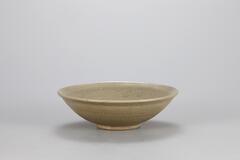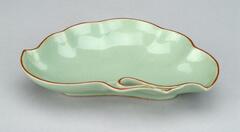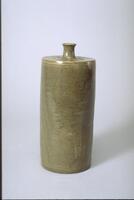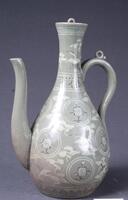Cabinet N: Shelf 3
Celadon Wares in Asia
Although Celadon is the term for a kind of translucent crackle glaze applied to porcelain and stoneware, it has come to mean wares that are specifically greenish blue or gray in color, particularly those from China and Korea. The trademark greenish hues of celadon wares were achieved through the use of clays and glazes that contained small amounts of iron, which turns green in a reduction firing atmosphere. (When there is insufficient oxygen in the air in a kiln, oxygen molecules are pulled from the ceramics themselves; it is this change in chemical composition that changes the color of the ware.) The thickness of the glaze and type of clay determine the color after firing, and getting the “right” effect is extremely difficult. The thin watery glaze runs off high points in the design and pools in impressions, creating dazzling gradations in color, especially in incised and molded designs.
Jade was prized in East Asia, and the ability to imitate its color in porcelain was highly valued. In the Goryeo Period (918-1392) in Korea, a celadon ewer or teacup was more precious than gold or silver. The high estimation of celadon was not limited to Korea, but extended to discerning connoisseurs at the court of the Northern Song dynasty (960–1127) in China. Celadon was quite popular in Japan as well, where it was both imported and manufactured in a native version. Celadon is considered by many to have reached its height during the Goryeo period, and these wares continue to be prized by collectors today.
![<p>This is a celadon lidded bowl with the top of the lid decorated with a peony spray design inside a hexafoil outline inlaid with black and white slips. The foot was made by removing clay from the underside of the base and retains traces of quartzite spurs in three places. The glaze was slightly darkened on the upper part with faint gloss. The glaze is poorly fused on the base of the body, leaving practically no sheen. The piece is of high value, however, for the glimpse it offers of Goryeo’s refined yet splendid inlaid celadon ware, thanks to its decorative design that depicts a peony in full bloom, inlaid with white clay.<br />
[<em>Korean Collection, University of Michigan Museum of Art </em>(2014) p.118]<br />
</p>
<p>This is a celadon lidded bowl with the top of the lid decorated with a peony spray design inside a hexafoil outline inlaid with black and white slips. The foot was made by removing clay from the underside of the base and retains traces of quartzite spurs in three places. The glaze was slightly darkened on the upper part with faint gloss. The glaze is poorly fused on the base of the body, leaving practically no sheen. The piece is of high value, however, for the glimpse it offers of Goryeo’s refined yet splendid inlaid celadon ware, thanks to its decorative design that depicts a peony in full bloom, inlaid with white clay.<br />
[<em>Korean Collection, University of Michigan Museum of Art </em>(2014) p.118]<br />
</p>](/media/W1siZiIsIjIwMjIvMDkvMjQvNmp1em12N3l3NF9kZWZhdWx0LmpwZyJdLFsicCIsInRodW1iIiwiMjQweDIwMCJdXQ?sha=f61ddb4ad28b4e42)
Cosmetic Box with inlaid peony (?) design: 6-lobed shape to lip top
stoneware with inlaid decoration under celadon glaze
1 1/8 x 3 3/16 x 3 3/16 in. (2.8 x 8 x 8 cm);7/8 x 2 9/16 x 2 9/16 in. (2.2 x 6.5 x 6.5 cm)
Gift of Bruce and Inta Hasenkamp and Museum purchase made possible by Elder and Mrs. Sang-Yong Nam
Created For
K-12 EducatorK-12 Student
Museum Visitor
UMMA Docent
UMMA Staff
University Faculty
University Student
Rate this Resource
AVG: 0 | Ratings: 0
& Author Notes
Creative Commons by-nc-saLast Updated
June 8, 2020 12:01 p.m.Report
Reporting Policy
![<p>The inner base and walls of this celadon dish are mold-impressed with a peony and peony scrolls, respectively. The low foot retains traces of quartzite supports in three places. The glaze is poorly fused, showing traces of its running, while partial oxidization has given the dish a yellow-green hue in parts.<br />
[<em>Korean Collection, University of Michigan Museum of Art </em>(2014) p.114]</p>
The rim of this celadon saucer is outward flared. Fine crackles are present throughout the surface of the saucer, coated with a dark bluish green glaze. It has glazed short foot with 3 spur marks and is molded peony design on wall and bottom. The exterior glaze color change due to over heating, fired in sagger that was not tightly closed. <p>The inner base and walls of this celadon dish are mold-impressed with a peony and peony scrolls, respectively. The low foot retains traces of quartzite supports in three places. The glaze is poorly fused, showing traces of its running, while partial oxidization has given the dish a yellow-green hue in parts.<br />
[<em>Korean Collection, University of Michigan Museum of Art </em>(2014) p.114]</p>
The rim of this celadon saucer is outward flared. Fine crackles are present throughout the surface of the saucer, coated with a dark bluish green glaze. It has glazed short foot with 3 spur marks and is molded peony design on wall and bottom. The exterior glaze color change due to over heating, fired in sagger that was not tightly closed.](/media/W1siZiIsIjIwMjIvMDkvMjQvM2I3YWQ3MmZ2OF9kZWZhdWx0LmpwZyJdLFsicCIsInRodW1iIiwiMjQweDIwMCJdXQ?sha=43157896c18036d2)



![<p>This oil bottle is decorated with inlaid white lines on the shoulder and four inlaid chrysanthemums on the body. It has the refractory spurs stuck on the foot and outer base, and the glaze is partially crawled around the foot. The foot is low and there are three quartzite spur marks. The glaze and the form of the bottle are good overall, despite partial damage.<br />
[<em>Korean Collection, University of Michigan Museum of Art </em>(2014) p.130]</p>
<p>This oil bottle is decorated with inlaid white lines on the shoulder and four inlaid chrysanthemums on the body. It has the refractory spurs stuck on the foot and outer base, and the glaze is partially crawled around the foot. The foot is low and there are three quartzite spur marks. The glaze and the form of the bottle are good overall, despite partial damage.<br />
[<em>Korean Collection, University of Michigan Museum of Art </em>(2014) p.130]</p>](/media/W1siZiIsIjIwMjIvMDkvMjQvNDlrcTJpZWZ1cF9kZWZhdWx0LmpwZyJdLFsicCIsInRodW1iIiwiMjQweDIwMCJdXQ?sha=84cc0897ee7ac71a)
![<p>Many lobed dishes of this kind were produced in the 13th century. This dish was shaped by using a mold. The flat and wide base, which has been pared down, has three quartzite spur marks. Glaze has been applied even down to the inner base and rim of the foot, but is thick and opaque. Colors of the inner and outer surfaces di er, with that of the inner surface being darker.<br />
[<em>Korean Collection, University of Michigan Museum of Art </em>(2014) p.115]</p>
This flower-shaped celadon bottle with impressed decorations has a flat bottom and slanting sides. The form of the vessel was produced using a mold. The thick wall gives the bowl a rough appearance. The everted mouth forms a flat rim in the shape of a flower. A green glaze is applied to the entire surface. <p>Many lobed dishes of this kind were produced in the 13th century. This dish was shaped by using a mold. The flat and wide base, which has been pared down, has three quartzite spur marks. Glaze has been applied even down to the inner base and rim of the foot, but is thick and opaque. Colors of the inner and outer surfaces di er, with that of the inner surface being darker.<br />
[<em>Korean Collection, University of Michigan Museum of Art </em>(2014) p.115]</p>
This flower-shaped celadon bottle with impressed decorations has a flat bottom and slanting sides. The form of the vessel was produced using a mold. The thick wall gives the bowl a rough appearance. The everted mouth forms a flat rim in the shape of a flower. A green glaze is applied to the entire surface.](/media/W1siZiIsIjIwMjIvMDUvMjUvNnFkb3d3bzJwcV9kZWZhdWx0LmpwZyJdLFsicCIsInRodW1iIiwiMjQweDIwMCJdXQ?sha=5da198d83e017ec3)
![<p>The inner surface of this bowl features an incised design of two parrots with long tails resembling phoenixes. e entire body of the bowl was glazed including the rim of the foot, on which remain three quartzite spur marks. Although some fireclay has fallen inside the kiln during ring and adhered to the inner surface of the bowl, the state of sintering is good. The piece as a whole is a high-quality ware with a glossy surface and a fine color of glaze. The base of the foot is cracked which occurred while drying before the application of glaze.<br />
[<em>Korean Collection, University of Michigan Museum of Art </em>(2014) p.94]</p>
high quality, incised, double-parrot motif shallow bowl, nice shallow fully glazed foot, three spur marks, firing discoloration, kiln trash fall on glaze, 11th century. <p>The inner surface of this bowl features an incised design of two parrots with long tails resembling phoenixes. e entire body of the bowl was glazed including the rim of the foot, on which remain three quartzite spur marks. Although some fireclay has fallen inside the kiln during ring and adhered to the inner surface of the bowl, the state of sintering is good. The piece as a whole is a high-quality ware with a glossy surface and a fine color of glaze. The base of the foot is cracked which occurred while drying before the application of glaze.<br />
[<em>Korean Collection, University of Michigan Museum of Art </em>(2014) p.94]</p>
high quality, incised, double-parrot motif shallow bowl, nice shallow fully glazed foot, three spur marks, firing discoloration, kiln trash fall on glaze, 11th century.](/media/W1siZiIsIjIwMjIvMDkvMjQvNWdrcXY3YnBzbV9kZWZhdWx0LmpwZyJdLFsicCIsInRodW1iIiwiMjQweDIwMCJdXQ?sha=3c44f3270b71b87f)
![It has a relatively wide mouth for its height and slighly surving sides. Originally, this tpye of bowl was first produced in celadon in the late Goryeo period and was made in large numbers in buncheong ware during the early Joseon period. The foot is shallow and roughly trimmed.<br />
<br />
Many of densely decorated buncheong wares, with the stamped technique, were produced for uses in government offices in the 15th century. The interior wall and base of the dish are decorated with stamped designs of scrolls and chrysanthemum bands, and a chrysanthemum, respectively, while on the exterior wall is inlaid with lutus petals. Four spur marks are left on the inner base, and sand is adhered to the entire rim of the foot, which evidences that this piece was placed on the floor during firing. The glaze was fused well and made a glossy surface.<br />
[Korean Collection, University of Michigan Museum of Art (2014) p.148] It has a relatively wide mouth for its height and slighly surving sides. Originally, this tpye of bowl was first produced in celadon in the late Goryeo period and was made in large numbers in buncheong ware during the early Joseon period. The foot is shallow and roughly trimmed.<br />
<br />
Many of densely decorated buncheong wares, with the stamped technique, were produced for uses in government offices in the 15th century. The interior wall and base of the dish are decorated with stamped designs of scrolls and chrysanthemum bands, and a chrysanthemum, respectively, while on the exterior wall is inlaid with lutus petals. Four spur marks are left on the inner base, and sand is adhered to the entire rim of the foot, which evidences that this piece was placed on the floor during firing. The glaze was fused well and made a glossy surface.<br />
[Korean Collection, University of Michigan Museum of Art (2014) p.148]](/media/W1siZiIsIjIwMjIvMDUvMjUvODMwbWttcWt1cl9kZWZhdWx0LmpwZyJdLFsicCIsInRodW1iIiwiMjQweDIwMCJdXQ?sha=888e0bd642c4723b)
![<p>This is an intact hair oil bottle; an invaluable source for the information it provides about the form of Goryeo celadon oil bottles. The foot was made by removing the clay from the bottom of the base, while the foot rim shows the trase of glaze having been wiped away and has small grains of sand ahered to it. Glaze was oxidized in parts, yielding a yellow-brown color, and fine crackles are formed on the glazed furace. Glaze was poorly fused and there are glaze runnings on the lower part of the body.<br />
[<em>Korean Collection, University of Michigan Museum of Art</em> (2014) p.129]</p>
<p>This is an intact hair oil bottle; an invaluable source for the information it provides about the form of Goryeo celadon oil bottles. The foot was made by removing the clay from the bottom of the base, while the foot rim shows the trase of glaze having been wiped away and has small grains of sand ahered to it. Glaze was oxidized in parts, yielding a yellow-brown color, and fine crackles are formed on the glazed furace. Glaze was poorly fused and there are glaze runnings on the lower part of the body.<br />
[<em>Korean Collection, University of Michigan Museum of Art</em> (2014) p.129]</p>](/media/W1siZiIsIjIwMjIvMDkvMjQvMTF3MHdzMzRjc19kZWZhdWx0LmpwZyJdLFsicCIsInRodW1iIiwiMjQweDIwMCJdXQ?sha=230528ea44a1924d)

![<p>This celadon bowl is undecorated. The glaze is poorly fused and is generally opaque. The foot is low and displays traces of sand supports. The sand, stuck to the foot and the outer base, suggests that the bowl was placed on the kiln floor during ring. Glaze had run down to the outer wall of the foot and accumulated, in parts.<br />
[<em>Korean Collection, University of Michigan Museum of Art</em> (2014) p.97]</p>
<br />
shallow bowl, grey color, sanf grit on foot, made in Boryung kiln of ching chung nam-do, often found in tombs in Kangwa Island, 13th century, diameter 6+13/16 inches, height: 1+7/8 inches <p>This celadon bowl is undecorated. The glaze is poorly fused and is generally opaque. The foot is low and displays traces of sand supports. The sand, stuck to the foot and the outer base, suggests that the bowl was placed on the kiln floor during ring. Glaze had run down to the outer wall of the foot and accumulated, in parts.<br />
[<em>Korean Collection, University of Michigan Museum of Art</em> (2014) p.97]</p>
<br />
shallow bowl, grey color, sanf grit on foot, made in Boryung kiln of ching chung nam-do, often found in tombs in Kangwa Island, 13th century, diameter 6+13/16 inches, height: 1+7/8 inches](/media/W1siZiIsIjIwMjIvMDkvMjQvOHE1b3plcHhsc19kZWZhdWx0LmpwZyJdLFsicCIsInRodW1iIiwiMjQweDIwMCJdXQ?sha=c943e4400629e91b)
